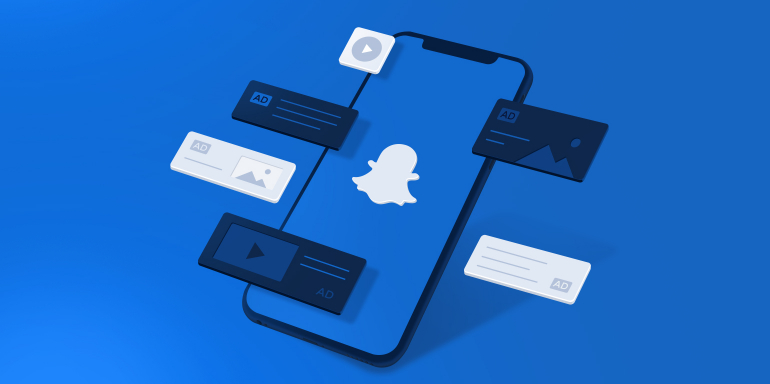Snapchat has been a game changer for social engagement since its inception. However, when it launched, other social advertising platforms were already so mainstream that brands were skeptical of its advertising and monetization potential. They didn’t see how it could ever compare.
Ironically, those popular social platforms, like Instagram and Facebook, are now copying many of Snapchat’s engagement features and advertising methods — Stories, real-time geo-targeting, and more.
Whether or not Snapchat grows to be as powerful as those other platforms, one thing is for certain: Snapchat ads are an advertising opportunity that marketers can’t ignore.
What are Snapchat ads?
Snapchat ads are mobile ads that allow you to connect with Snapchatters by creating engaging, interactive, sharable content, beyond the normal direct ad experience. With a variety of campaign objectives, targeting, and ad types available, Snapchat advertising can be effective for all marketers, no matter their budget or advertising goals.
Here’s an example of one type of Snapchat advertising — a Snap Ad from Vivint:
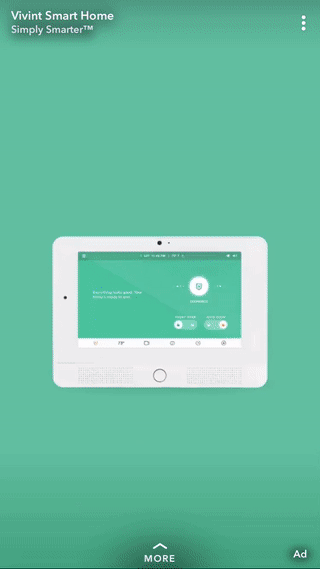
At first, the Snapchat advertising cost was extremely costly with limited choices for ad formats, and they could only be purchased through Snapchat’s sales team or third-party ad tools that often charged a fee. They were costing businesses hundreds of thousands of dollars, and brands couldn’t even advertise on Snapchat unless they were spending a minimum of $1,000 per day.
Thanks to the self-serve Snapchat ads manager, businesses of all sizes and budgets can buy ads at affordable prices directly from Snapchat. Minimum spend requirements don’t exist anymore, advertisers can pay per thousand impressions or per goal, and there are many different types of ad formats.
Before we detail the ad formats, here’s a brief overview of the objective and targeting options available.
Objectives
Awareness
- Branding
Consideration
- App Installs
- App Traffic
- Website Traffic
- Engagement
- Video Views
- Lead Generation
Conversions
- App Conversions
- Website Conversions
- Catalog Sales
Targeting options
Interests and behaviors
- Reach users based on the things they like and do, both on and off Snapchat
Demographics
- Target users by age, gender, household income, parental status, etc.
Location
- Find users by country, location category (like “universities”), radiuses around a specific address, etc.
Custom Audiences
- Retarget users who have already seen your ads and/or engaged with your business
Lookalikes
- Expand your reach by targeting users similar to existing customers
And now for the wide variety of Snapchat ad formats.
Snapchat advertising examples
1. Snap Ads
Snap Ads were the first ad format launched by Snapchat, and therefore, provide the most traditional ad experience on the platform. These are full-screen Snapchat ads between stories that are shown for a maximum of 10 seconds:

They can be created in the form of video (live or animated), gif, still, or cinemagraph, and closely match the Snap Story experience to feel more like normal Snapchat content than ads.
Since the length of these ads is very short, many brands use “sequenced messaging” to tell a longer story. They create a series of Snapchat video ads and upload them together to create what seems like a longer video to tell a complete story about your brand.
There are several different types of Snap Ads, most of which include a swipe up option for advertisers to add an attachment purchased through the Snapchat ads manager:
Top Snap Ads
These are standard Snap Ads that display a single piece of content — either an image, video, or gif — at the top of users’ feeds. They are ideal for driving brand awareness, and for promoting events, sales, or other one-off activities:
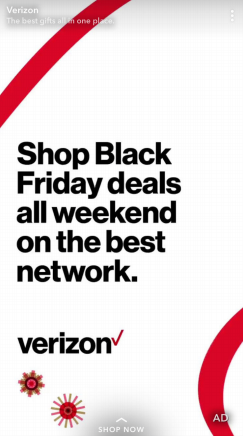
Although you can’t add clickable hyperlinks to Top Snap Ads, you can show specific URLs as copy on them.
Ad Specs
- Full-screen Canvas: 1080×1920 px, 9:16 aspect ratio, scaled proportionally to original asset.
- File Format: MP4, MOV, H.264 encoded, storage aspect ratio should be 1:1.
- Acceptable Creatives: Live, motion graphic, or stop motion video, cinemagraph, slideshow, GIF-like, still image.
- Length: 3-10 seconds
- File size: 32MB or less
- Audio: Must utilize 2 channels in a balanced way throughout, audio target level should be -16 LUFS, PCM or AAC codec, 192 minimum kbps, 16 or 24-bit only, 48 KHz sample rate.
Web View Ads
Web View Ads offer the same visual experience as Top Snap Ads, with the added bonus of a call-to-action. When a user swipes up on a Web View Ad, they’re instantly directed to your website (without even opening a browser), where they can learn more about your offer, and engage with more content:
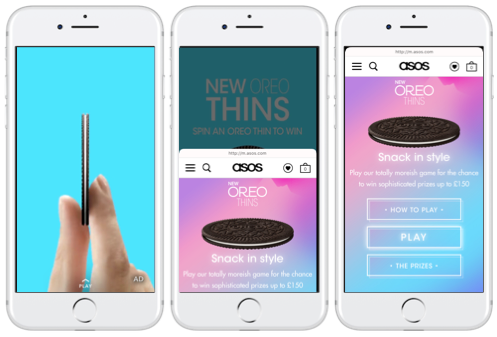
These ads are particularly useful for introducing your brand to Snap users.
Ad Specs
- Full-screen Canvas: 1080×1920 px, 9:16 aspect ratio, scaled proportionally to original asset.
- File Format: MP4, MOV, H.264 encoded, storage aspect ratio should be 1:1.
- Acceptable Creatives: Live, motion graphic, or stop motion video, cinemagraph, slideshow, GIF-like, still image.
- Length: 3-10 seconds.
- File size: 32MB or less.
- Audio: Must utilize 2 channels in a balanced way throughout, audio target level should be -16 LUFS, PCM or AAC codec, 192 minimum kbps, 16 or 24-bit only, 48 KHz sample rate.
- Provided destination URL must work in mobile Safari and mobile Chrome.
- Vertically-oriented experiences (as the Web View does not rotate into landscape mode).
App Install Ads
These ads also look similar to Top Snap Ads, but they include a “swipe up” feature that takes users directly to your app post-click landing page in a marketplace to download the promoted app:
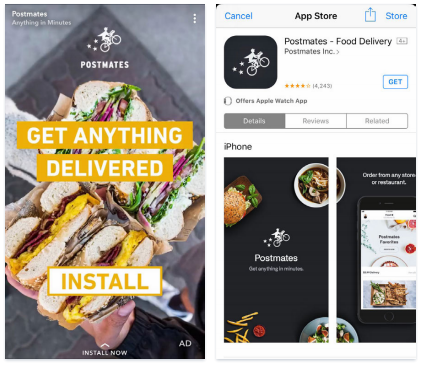
The main benefit here is that users don’t leave Snapchat to download the app — it downloads in the background as users continue to use the platform.
Ad Specs
- App ID and URLs for both Google Play and iTunes App Stores:
- Google Play store ID can be found after “id=” in store url (e.g. Snapchat’s Google Play app id is “com.snapchat.android”)
- Apple Store ID should be the numeric value only (e.g. Snapchat’s Apple Store id is “447188370”)
- 200×200 px App Icon (PNG)
- Full-screen Canvas: 1080×1920 px, 9:16 aspect ratio, scaled proportionally to original asset.
- File Format: MP4, MOV, H.264 encoded, storage aspect ratio should be 1:1.
- Acceptable Creatives: Live, motion graphic, or stop motion video, cinemagraph, slideshow, GIF-like, still image
- Length: 3-10 seconds.
- File size: 32MB or less.
- Audio: Must utilize 2 channels in a balanced way throughout, audio target level should be -16 LUFS, PCM or AAC codec, 192 minimum kbps, 16 or 24-bit only, 48 KHz sample rate
Deep Link Ads
Deep Link Ads are used to get people back into your app once they’ve left, by combining attention-grabbing media and a link that users can click to open your app straight from the ad creative.
Ad Specs
- Needed: iOS App ID, Google Play App ID, Deep Link URL to define the point in your app you want to send users who have your app to (e.g. snapchat://MyStory123abc, iOS and Android App icons in 512×512)
- Full-screen Canvas: 1080×1920 px, 9:16 aspect ratio, scaled proportionally to original asset.
- File Format: MP4, MOV, H.264 encoded, storage aspect ratio should be 1:1.
- Acceptable Creatives: Live, motion graphic, or stop motion video, cinemagraph, slideshow, GIF-like, still image.
- Length: 3-10 seconds.
- File size: 32MB or less.
- Audio: Must utilize 2 channels in a balanced way throughout, audio target level should be -16 LUFS, PCM or AAC codec, 192 minimum kbps, 16 or 24-bit only, 48 KHz sample rate.
Long Form Video Ads
Long Form Video Ads can be used to show lengthier media, like trailers, behind-the-scenes footage, how-to’s, and short films. With this ad type, viewers will see a short 10-second teaser, and swipe up to view an extension up to 1 GB in size:

Ad Specs
- File Format: MP4 or MOV, H.264 encoded.
- Audio: 2 channels only, PCM or AAC codec, 192 minimum kbps, 16 or 24 bit only, 48 KHz sample rate.
- Minimum length: 15 sec (no max) live and/or Motion Graphic video.
- Maximum size: 1 GB
2. Collection Ads
These ads are formatted like product catalogs, allowing you to showcase up to four products at a time:
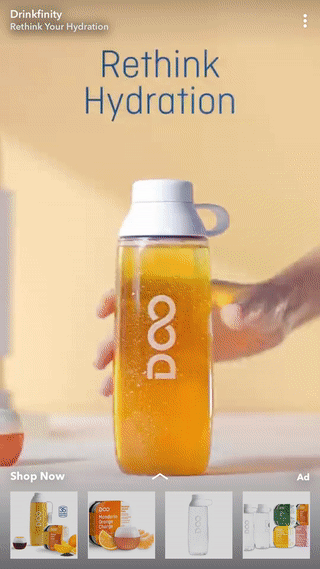
They are placed just like Snap Ads (in between stories), giving users a tappable, frictionless way to shop and buy your products.
As far as Snapchat advertising statistics — retailers using Collection Ads have seen anywhere from 4.1 to 17 times higher engagement rates than standard Snap Ads. Guess, for example, saw its engagement rate increase 4X, while eBay’s improved 5x.
3. Story Ads
Snapchat Story Ads (aka Snapchat Discover Ads) allow advertisers to reach their audiences with a sponsored tile in the Discover feed:

Since your ad is positioned alongside other popular content tailored to the user’s preferences, users can jump into a collection of 3-20 Snaps to see more of your content with just one tap:
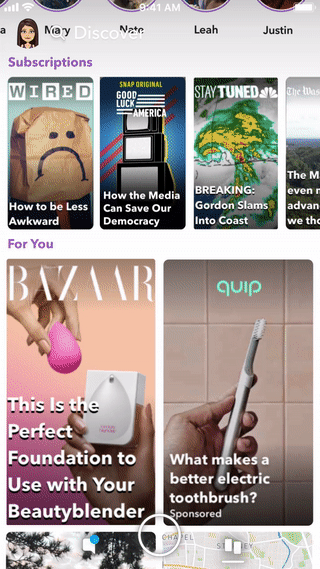
4. AR Lenses
This ad type allows brands to build and apply custom lenses for Snapchatters to use while taking selfies:

Lenses are designed for users to make fun modifications to their face or surroundings and used by more than one-third of daily active users. With such high usage, Sponsored Lenses are a great way for brands to show and enhance their brands with an augmented reality experience, especially around major holidays, events, or industry campaigns:
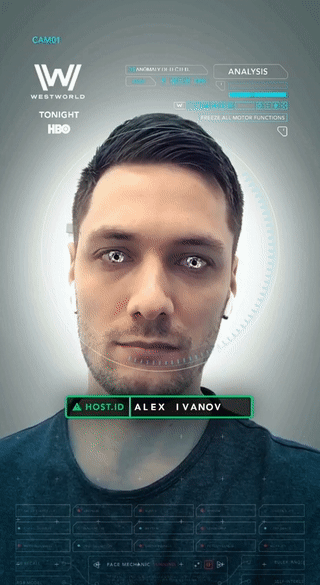
Sponsored AR Lenses are the most expensive Snapchat ads — ranging from $450,000 to $700,000 per day — because they cover such a large area and are seen by millions of people. Because of how expensive they are, these ads are typically used by very large brands with large ad budgets.
5. Filters
In addition to adding lenses to their Snaps, users can also add filters to their photos and videos by swiping left or right. The filter graphics then cover part of the user’s screen:

With Sponsored Filters, advertisers can insert themselves into Snapchatters’ conversations with creative overlays that promote brand awareness.
They can be generic like this:

Or geo-specific, set to very targeted geographic areas. Geofilters are used at least 2.16 billion times per day in one of two forms: Sponsored Geofilters and On-Demand Geofilters.
Sponsored Geofilters
Geofilters can be added to privately sent photos and videos, or to publicly shared posts in Stories. The overlay depends on where users are located — targeted to very specific locations or as broad as country-wide:

Snapchat even allows brands to set up Geofilters to only display within a certain radius of physical stores across the country. This allows for a nationwide reach, without wasting budget on unserved areas.
Due to their wide reach, Sponsored Geofilters can get expensive, similar to Sponsored Lenses. Therefore, these are also generally used by bigger brands. It’s worth mentioning, though, that Snapchat has been known to offer this ad type for free to universities, cities, and similar organizations.
On-Demand Geofilters
These are very similar to Sponsored Geofilters but are much less expensive as they’re designed to use in a localized area for a short period. Prices start at just $5 for a small area for about an hour, and a small city block would cost about $45.
On-demand Geofilters are great for hosting sale events, conferences, parties, product launches, store openings, etc. where attendees can access the filter from the event, and help you spread brand awareness. All you have to do is design a filter and submit it for approval. Once approved, your filter can be available for a few hours or a few days, based on how much traffic you want. For more on geofilters and how to create them, go here.
Snapchat advertising best practices
No matter the ad type, the best Snapchat ads follow these four best practices:
1. Consider your audience
Snapchat Ads that result in the most clicks, engagement, and conversion:
- Cater to audiences younger than 30 years old
- Incorporate the app features this demographic uses regularly
- Show at a frequency that matches the amount of time users spend online
They also maintain a native style, designed according to Snapchat’s overall vibe, with Snapchat-specific features, speaking directly to the camera, etc.
2. Make content fun and shareable
Get creative and embrace a playful feel for your ads so users will interact more. Engaging your audience with filters and lenses is likely to increase the odds they’ll share Snaps across their other social networks. So even if you aren’t advertising on other social networks, your brand is still showing up there as people share.
3. Keep it short and simple
Although 10-second video ads might seem short, Snapchat recommends 3-5 seconds to drive action. They also suggest establishing your brand message or offer around the 2-second mark to maximize awareness, with a voiceover CTA to encourage users to swipe up (since over 60% of Snapchat Ads are watched with sound on).
4. A/B test and improve performance
As always, specific elements of your ad should be incrementally split tested, and your campaign results tracked and measured. This allows you to see what’s producing the best conversion results, and what’s negatively impacting your results. Also, be sure to test various Snapchat ad formats to see which ones resonate best with your audience.
Engage your target audience with Snapchat advertising
Snapchat advertising can be a very effective way to increase brand awareness and engagement, drive traffic, and boost sales. Now, with so many unique ad types, you’re sure to find an appropriate ad format, no matter your budget or campaign goal.
To fully optimize your Snapchat ad, refer to the Instapage digital advertising reference guide for up to date ad specs, targeting options, and more.
